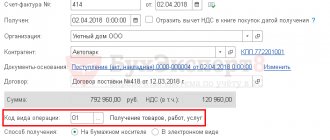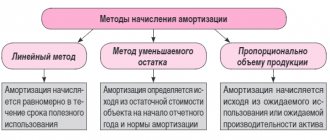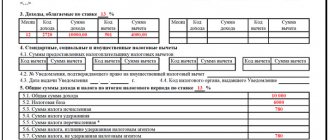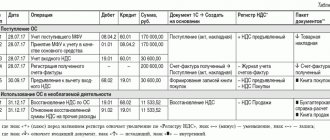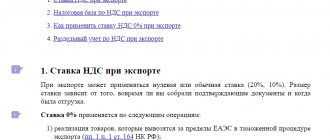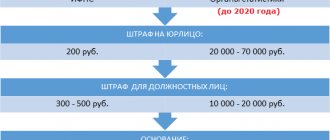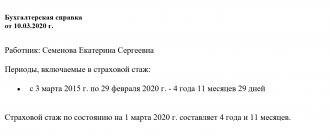Offsetting mutual claims and VAT in 2020-2021 in the absence of termination of the agreement
Currently, the offset of mutual claims under the Civil Code of the Russian Federation, which occurs in terms of existing debts under existing agreements and, in essence, is a form of debt payment, does not entail any consequences in relation to VAT, despite the fact that in the documents formalizing the offset mutual requirements according to the sample, its amount is indicated.
This is due to the fact that the acceptance of VAT for deduction on goods, works, services purchased on the territory of the Russian Federation, starting from 2009, is in no way related to the fact of payment of this tax. Read more about the deduction procedure in the article “What is the procedure for applying (accepting) tax deductions for VAT: conditions” .
Thus, in order to make a deduction for purchases made in the Russian Federation, the simultaneous presence of three circumstances turns out to be important (Articles 171 and 172 of the Tax Code of the Russian Federation):
- the purchase is intended for use in transactions subject to VAT;
- the purchased item has been capitalized;
- there is an invoice issued without errors critical for deducting VAT.
Offsetting mutual claims in such a situation represents the repayment of mutual debts (payment), which are not reflected in the fact of the deduction.
Find out about the tax and accounting consequences of offsetting mutual claims in the Transaction Guide from ConsultantPlus. To do this, get trial access to the K+ system and study the material for free.
VAT deduction from advance payment
The tax amounts previously accrued from the advance payment can be deducted by the seller (executor):
- if the goods for which advance payment has been received have been shipped. Or the work is completed, the services are provided. The tax must be deducted on the date of shipment, regardless of whether the title has passed from the supplier to the buyer or not. In this case, you can deduct only the amount of tax that is accrued from the cost of goods shipped, work performed or services rendered. For example, if an advance is received in the amount of RUB 1,180,000. (including VAT - 180,000 rubles), and against this advance, goods worth 118,000 rubles were shipped. (including VAT - 18,000 rubles), upon shipment the seller can deduct only 18,000 rubles. (clause 8 of article 171, clause 6 of article 172 of the Tax Code of the Russian Federation, letter of the Ministry of Finance of Russia dated November 28, 2014 No. 03-07-11/60891);
- if the parties terminated or changed the contract under which the advance payment was received, and the supplier returned the advance to the buyer. Submit the tax for deduction after the return of the advance payment has been reflected in accounting, but no later than a year after the change or termination of the contract (clause 4 of Article 172 of the Tax Code of the Russian Federation). This deduction cannot be transferred to later periods: the right to refund VAT for three years does not apply to deductions related to the return of advances (subclause 1.1 of Article 172 of the Tax Code of the Russian Federation, letter of the Ministry of Finance of Russia dated July 21, 2015 No. 03-07- 11/41908). A prerequisite for deducting VAT is the payment of tax on advances to the budget (clause 5 of Article 171 of the Tax Code of the Russian Federation). Moreover, if the supplier received and returned the advance payment within one quarter, then he has the right to accept tax as a deduction in the same tax period (letter of the Federal Tax Service of Russia dated May 24, 2010 No. ШС-37-3/2447 (agreed with the Ministry of Finance of Russia)) .
Attention: if you charge VAT on an advance payment for the subsequent transfer of property rights, this tax cannot be deducted.
The fact is that VAT can be deducted only from those advances that the seller received for upcoming deliveries of goods, performance of work or provision of services (clause 8 of Article 171 of the Tax Code of the Russian Federation). This provision says nothing about property rights. Thus, the seller is not entitled to deduct tax on the advance payment he received on account of their subsequent transfer. This means that after the transfer of property rights, the organization will have to charge VAT again, but it will not be able to reimburse the tax amounts accrued from the advance payment.
Since in such a situation the seller will have an overpayment of VAT, the Russian Ministry of Finance suggests contacting the tax office with an application for a credit or refund of the overpaid tax (letter dated March 30, 2015 No. 03-07-15/17428).
For example, in June, an organization received an advance from a counterparty for the subsequent transfer of property rights. Advance amount – 118,000 rubles. VAT on the advance received was reflected in the declaration for the second quarter and transferred to the budget as part of total payments in the amount of 18,000 rubles. (RUB 118,000 × 18/118). In July, the organization transferred property rights, in payment for which an advance was received. The cost of transferred property rights is 177,000 rubles. (including VAT – 27,000 rubles). The amount of VAT accrued upon the transfer of property rights is reflected in the tax return for the third quarter. At the same time, the accountant did not deduct the amount of VAT accrued from the advance payment. Simultaneously with the declaration for the third quarter, the accountant submitted an application to the tax office with a request to offset the amount of VAT from the advance payment against current payments.
An example of reflecting VAT transactions in accounting when returning an advance received
In the third quarter (September), JSC “Proizvodstvennaya” received from JSC “Alfa” a 100 percent prepayment under the purchase and sale agreement for finished products. The advance amounted to 118,000 rubles. (including VAT – 18,000 rubles).
According to the terms of the contract, finished products should be shipped to Alpha in the fourth quarter (October).
The amount of VAT calculated from the prepayment is reflected in the declaration for the third quarter (September) and paid to the budget in October.
By the deadline established in the contract, “Master” did not manage to produce the required quantity of products and did not deliver. On November 1, the contract between “Master” and “Alpha” was terminated. On the same day, “Master” returned to “Alfa” the advance received in the amount of 118,000 rubles. (including VAT – 18,000 rubles).
To account for settlements with customers on advances received, the “Masters” accountant uses the subaccount “Settlements on advances received”, opened to account 62.
The “Master” accountant reflected the operation to return the advance in accounting as follows:
Debit 62 subaccount “Settlements on advances received” Credit 51 – 118,000 rubles. – the advance amount was returned to the buyer;
Debit 68 subaccount “Calculations for VAT” Credit 76 subaccount “Calculations for VAT from advances received” – 18,000 rubles. – the amount of VAT accrued and paid from the prepayment amount is accepted for deduction.
Special rules apply for step-by-step advance payment. In this case, determine the amount of the deduction taking into account the terms of the contract. If the contract stipulates that the advance payment is not included in payment for goods shipped (work performed, services provided) not in full, but in part, then deduct VAT in the same proportional ratio.
This follows from the provisions of paragraph 8 of Article 171, paragraph 6 of Article 172 of the Tax Code of the Russian Federation.
An example of reflecting VAT transactions in accounting upon receipt of partial prepayment
In March, Proizvodstvennaya JSC received an advance payment from Alfa JSC for the upcoming phased shipment of products. The cost of shipment under the contract is 1,500,000 rubles. The prepayment amount is RUB 590,000. The contract stipulates that the advance payment is counted in the amount of 50 percent of the cost of each shipment, the remaining amount is paid by the buyer at each stage of shipment.
Products worth RUB 944,000. (including VAT - 144,000 rubles) was shipped to Alfa in April. Its cost was 650,000 rubles.
Part of the advance payment in the amount of 472,000 rubles was credited to the shipment. (50% of RUB 944,000). The remaining part is 472,000 rubles. (944,000 rubles - 472,000 rubles) - “Alpha” transferred to “Master” after the products were shipped (in April).
To account for settlements with customers, the accountant uses sub-accounts opened to account 62 - “Settlements for advances received” and “Settlements for shipped products”. It reflects the deduction of VAT using the subaccount “Calculations for VAT on advances received”, opened to account 76 “Settlements with various debtors and creditors”.
The following entries were made in the Master's accounting.
In March:
Debit 51 Credit 62 subaccount “Settlements on advances received” – 590,000 rubles. – partial prepayment was received from Alpha for the upcoming delivery of products;
Debit 76 subaccount “Calculations for VAT on advances received” Credit 68 subaccount “Calculations for VAT” - 90,000 rubles. (RUB 590,000 × 18/118) – VAT is charged on the prepayment amount.
In April:
Debit 62 subaccount “Settlements for shipped products” Credit 90-1 – 944,000 rubles. – revenue from sales of products (1st batch) is reflected;
Debit 90-2 Credit 41 – 650,000 rub. – the cost of products sold is written off;
Debit 90-3 Credit 68 subaccount “VAT calculations” – 144,000 rubles. – VAT is charged on sales proceeds;
Debit 68 subaccount “Calculations for VAT” Credit 51 – 90,000 rubles. – VAT is transferred to the budget from the prepayment amount (as part of the total tax amount according to the declaration for the first quarter);
Debit 68 subaccount “Calculations for VAT” Credit 76 subaccount “Calculations for VAT from advances received” – 45,000 rubles. – VAT accrued on prepayment is accepted for deduction in an amount corresponding to part of the cost of the shipped products;
Debit 62 subaccount “Settlements for advances received” Credit 62 subaccount “Settlements for shipped products” - 472,000 rubles. – the prepayment was partially offset against the cost of shipped products;
Debit 51 Credit 62 subaccount “Settlements for shipped products” – 472,000 rubles. – the debt for payment for shipped products has been repaid.
An example of reflecting VAT transactions in accounting when receiving an advance payment in foreign currency
JSC Alfa provides educational services (conducts seminars) on orders from foreign organizations in Russia. The services provided by Alfa are subject to VAT (subclause 3, clause 1, article 148 of the Tax Code of the Russian Federation).
In January, Alpha entered into an agreement to conduct a seminar with the following conditions:
- the cost of educational services is USD 11,800 (including VAT – USD 1,800);
- advance payment of 100 percent is due on January 11;
- The seminar is held on January 27.
The conventional US dollar exchange rate was:
- on January 11 – 31 rubles/USD;
- on January 27 – 30 rubles/USD.
If a contract, the value of which is expressed in foreign currency, provides for partial (100%) prepayment, then in accounting the amount of the advance received (revenue) is not recalculated either on the reporting date, or on the date of shipment, or on the date of final settlements with the buyer (p 9 and 10 PBU 3/2006). Therefore, exchange rate differences do not arise under both agreements. A similar rule applies in tax accounting: when receiving an advance, the amount of proceeds from sales in the part attributable to the advance is determined at the exchange rate established on the date of receipt of the advance (paragraph 3 of Article 316 of the Tax Code of the Russian Federation). Since the procedure for recognizing revenue in accounting and tax accounting does not differ, permanent differences do not arise.
The tax base for VAT under such agreements is determined twice. First, in rubles at the Bank of Russia exchange rate valid on the date of receipt of payment from the customer (clause 3 of Article 153, subclause 2 of clause 1 of Article 167 of the Tax Code of the Russian Federation). After the services are actually provided, again - in rubles at the Bank of Russia exchange rate in effect on the date of provision of services (clause 14 of article 167, clause 1 of article 154, clause 3 of article 153 of the Tax Code of the Russian Federation). At the same moment, the amount of VAT accrued from the prepayment is accepted for deduction (clause 6 of Article 172 of the Tax Code of the Russian Federation).
To reflect transactions related to receiving prepayments and providing educational services, I opened subaccounts to account 62 “Settlements with buyers and customers”:
- 62 subaccount “Settlements on advances received”;
- 62 subaccount “Settlements for services rendered”.
The following entries were made in accounting.
January 11:
Debit 52 Credit 62 subaccount “Settlements on advances received” – 365,800 rubles. (11,800 USD × 31 rubles/USD) – an advance was received to pay for services;
Debit 76 subaccount “Calculations for VAT on advances received” Credit 68 subaccount “Calculations for VAT” - 55,800 rubles. (RUB 365,800 × 18/118) – VAT is charged on the prepayment amount.
January 27:
Debit 62 subaccount “Settlements for services rendered” Credit 90-1 – 365,800 rubles. – revenue from the sale of services is reflected (at the exchange rate on the date of receipt of the advance).
To determine the tax base for VAT, the accountant calculated revenue at the US dollar exchange rate on the date of provision of services. It amounted to 354,000 rubles. (11,800 USD × 30 rubles/USD). The amount of VAT on the amount of revenue is 54,000 rubles. (RUB 354,000 × 18/118).
Debit 90-3 Credit 68 subaccount “VAT calculations” – 54,000 rubles. – VAT is charged on revenue from the provision of services;
Debit 62 subaccount “Settlements for advances received” Credit 62 subaccount “Settlements for services rendered” - 365,800 rubles. – the received advance is offset against payment under the contract;
Debit 68 subaccount “Calculations for VAT” Credit 76 subaccount “Calculations for VAT from advances received” – 55,800 rubles. – accepted for deduction of VAT on advance payment.
Situation: can the seller deduct VAT from the advance payment if he transferred the tax amount to the budget, but did not ship the goods (work, services) as an advance payment? The seller wrote off the accounts payable in the amount of the advance upon expiration of the statute of limitations.
No, he can not.
After all, VAT can be deducted from an advance payment only in two cases:
- after shipment of goods (performance of work, provision of services) (clause 8 of Article 171, clause 6 of Article 172 of the Tax Code of the Russian Federation);
- upon termination (change of terms) of the contract and return of the advance to the counterparty. A prerequisite for deduction is that the seller had to transfer VAT on the advance payment to the budget (clause 5 of Article 171, clause 4 of Article 172 of the Tax Code of the Russian Federation).
There are no provisions in Chapter 21 of the Tax Code of the Russian Federation that allow the seller to accept VAT from the advance as a deduction when writing off accounts payable.
Also, the seller will not be able to:
- include the VAT amount as expenses that reduce taxable profit. The fact is that the VAT, which the supplier pays to the budget when receiving an advance payment, is presented to the buyer (paragraph 2, paragraph 1, article 168 of the Tax Code of the Russian Federation). And sellers do not take into account the amount of taxes presented to buyers in expenses (clause 19 of Article 270 of the Tax Code of the Russian Federation);
- take into account VAT in expenses as when writing off accounts payable for purchased goods, works, services (subclause 14, clause 1, article 265 of the Tax Code of the Russian Federation). In the situation under consideration, the organization did not purchase anything - it only received funds as an advance payment for upcoming deliveries. Therefore, there is no reason to reduce taxable profit by the amount of VAT on the advance payment, which you write off due to the expiration of the statute of limitations.
Include the entire amount of the advance (including VAT) in non-operating income (clause 18 of Article 250 of the Tax Code of the Russian Federation).
Similar clarifications are contained in the letter of the Ministry of Finance of Russia dated February 10, 2010 No. 03-03-06/1/58.
Advice: if you are ready for disputes with inspectors, then VAT on the unprocessed advance payment, which was written off after the expiration of the statute of limitations, can be included in expenses. The following arguments will help in the dispute.
Having received an advance, the seller (executor) must present to the buyer (customer) the amount of VAT determined at the estimated rate of the advance received (paragraph 2, clause 1, article 168 of the Tax Code of the Russian Federation). If the advance payment has not been processed, then after the expiration of the limitation period, the resulting accounts payable must be included in non-operating income (clause 18 of Article 250 of the Tax Code of the Russian Federation). The debt also includes the amount of VAT charged to the buyer (customer).
As a general rule, when calculating income tax, an organization excludes from income the amounts of taxes that it imposes on its counterparties (paragraph 5, paragraph 1, article 248 of the Tax Code of the Russian Federation). Consequently, the seller must reduce accounts payable - the unpaid advance - by the amount of VAT calculated on this advance. In arbitration practice there are examples of court decisions that confirm the legality of this approach (see, for example, decisions of the FAS Moscow District dated March 19, 2012 No. A40-75954/11-115-241, Northwestern District dated October 24, 2011 No. A42-9052/2010).
Situation: is it possible to deduct the VAT amount calculated from the advance payment at the rate of 18/118? In exchange for the advance payment, the seller will ship goods subject to different tax rates. As of the date of receipt of the advance payment, the quantity of goods is unknown.
Yes, you can.
Having received an advance, the selling organization is obliged to calculate the amount of VAT on the advance and transfer it to the budget. It is possible that at the time of receiving the advance, the seller does not know how much he will ship of goods taxed at a rate of 10 percent. Then he must charge VAT on the entire advance amount at the calculated rate of 18/118. This follows from the provisions of paragraph 4 of Article 164 and subparagraph 2 of paragraph 1 of Article 167 of the Tax Code of the Russian Federation.
After shipment of goods, the seller has the right to deduct VAT from the advance payment (clause 8 of Article 171 of the Tax Code of the Russian Federation). At the same time, the legislation does not limit the amount of deduction depending on what goods are actually sold as an advance payment: subject to VAT at a rate of 18 or 10 percent.
The seller received an advance payment for the upcoming delivery of goods of an unspecified range. For example, at the time of receipt of the advance payment, the quantity and nomenclature of the supply were not agreed upon by the parties. Then, after shipment, the seller can submit for deduction VAT, accrued at a rate of 18/118 on the entire advance amount. Even if all goods supplied as an advance payment are subject to VAT at a 10% rate. The validity of this conclusion is confirmed by Resolution of the Presidium of the Supreme Arbitration Court of the Russian Federation dated January 25, 2011 No. 10120/10.
In addition, in this resolution, the Presidium of the Supreme Arbitration Court of the Russian Federation recognized that the tax inspectorate does not have the right to demand from the seller updated declarations for the period in which the advance was received. This position is based on the provisions of paragraph 1 of Article 81 and paragraph 1 of Article 54 of the Tax Code of the Russian Federation. According to these standards, an organization is obliged to submit an updated declaration only if it discovered inaccuracies or errors in a previously submitted declaration, due to which it transferred a smaller amount of tax to the budget.
In the situation under consideration, charging VAT at a rate of 18/118 on the entire advance amount is not an error. The organization complied with the requirements of subparagraph 2 of paragraph 1 of Article 167 of the Tax Code of the Russian Federation.
Situation: can the contractor deduct the entire amount of VAT from the advance upon termination of the contract? The contractor returns only part of the advance to the customer. Before termination of the contract, the contractor incurred costs, which the customer reimburses by refusing to return part of the advance
No, he can not. Only part of the VAT on the advance payment will be deductible.
As a general rule, VAT deduction is possible only if the advance payment is returned to the customer (paragraph 2, paragraph 5 and paragraph 8, article 171 of the Tax Code of the Russian Federation). And in this situation, the contractor returns the advance partially. The other part goes to reimburse the contractor’s costs associated with the start of execution of the contract (Article 782 of the Civil Code of the Russian Federation).
If so, then VAT can only be deducted from the refunded amount. Determine the amount of the deduction in proportion to the share of the refunded funds in the total amount of the previously received advance.
In turn, the customer must fully refund the amount of VAT that he accepted for deduction from the previously transferred prepayment. This is stated in subparagraph 3 of paragraph 3 of Article 170 of the Tax Code of the Russian Federation.
An example of VAT calculation upon termination of a contract for the provision of services. The customer compensates the contractor for expenses incurred in connection with the commencement of execution of the contract
On June 1, Torgovaya LLC and Alfa JSC entered into an agreement to provide information to Alfa, ordering it to conduct marketing research in one of the constituent entities of the Russian Federation and assess the prospects for selling its products on the regional market. As an advance payment under the agreement, Hermes transferred 236,000 rubles to Alpha.
To execute the contract, Alpha hired local specialists who carried out preliminary work to study the situation. However, in July, without waiting for the final report, Hermes refused the ordered services and demanded termination of the contract. At the same time, he agreed to reimburse all documented expenses incurred by Alpha in connection with the commencement of the contract.
On the amount of the prepayment received, Alpha charged VAT in the amount of 36,000 rubles. (RUB 236,000 × 18/118) and issued an invoice to Hermes with the allocated tax amount. The accrual of VAT is reflected in the tax return for the second quarter.
The amount of expenses incurred by Alfa in connection with the execution of the contract amounted to 60,000 rubles. By agreement with the customer, Alpha withholds this amount from the previously received advance payment and returns the advance payment in the amount of 176,000 rubles to Hermes. (RUB 236,000 – RUB 60,000).
The accountant calculated the amount of VAT to be deducted in relation to the refundable advance amount:
RUB 176,000: RUB 236,000 × 36,000 rub. = 26,847 rub. (or 176,000 rubles × 18/118 = 26,847 rubles)
Alpha claims this amount for deduction in its declaration for the third quarter.
In Alpha's accounting, transactions related to the calculation of VAT are reflected as follows.
In June:
Debit 51 Credit 62 subaccount “Settlements on advances received” – 236,000 rubles. – an advance payment has been received from the customer for the provision of services;
Debit 76 subaccount “Calculations for VAT on advances received” Credit 68 subaccount “Calculations for VAT” - 36,000 rubles. – VAT is charged on the amount of the prepayment received.
In July:
Debit 76 Credit 91-1 – 60,000 rub. – the customer’s debt for reimbursement of expenses is reflected (as of the date of termination of the contract);
Debit 62 subaccount “Settlements on advances received” Credit 76 – 60,000 rubles. – the amount of expenses incurred is withheld from the advance received;
Debit 62 subaccount “Settlements on advances received” Credit 51 – 176,000 rubles. – the remainder of the advance was returned to the customer;
Debit 68 subaccount “Calculations for VAT” Credit 76 subaccount “Calculations for VAT from advances received” – 26,847 rubles. – accepted for deduction of VAT on the returned advance amount.
Advice: if you are ready to argue with the inspectors, then when terminating the contract, you can deduct the entire amount of VAT previously accrued from the prepayment. The following arguments will help you in the dispute.
In the situation under consideration, the seller and buyer essentially use offset, which is one of the options for repaying mutual obligations (Article 410 of the Civil Code of the Russian Federation). Therefore, the amount that the contractor withholds from the previously received advance payment can be qualified as returned to the customer. This means that the conditions for deducting VAT from the advance payment have been met: the contract has been changed or terminated, and the seller has returned the advance payment to the buyer. This follows from the provisions of paragraph 2 of paragraph 5 of Article 171 of the Tax Code of the Russian Federation.
There are no requirements in Chapter 21 of the Tax Code of the Russian Federation that the seller must return the advance payment to the buyer exclusively in cash.
Moreover, the Ministry of Finance of Russia allows that the seller can deduct VAT from the advance payment if he does not return the advance payment to the buyer (customer), but counts it against the fulfillment of other obligations (letters dated November 12, 2012 No. 03-07-11/482 , dated September 11, 2012 No. 03-07-08/268, dated June 22, 2010 No. 03-07-11/262).
Nevertheless, disagreements with the tax inspectorate are not excluded. And you may have to defend your position in court. But the chances of winning the argument are very high. The Plenum of the Supreme Arbitration Court of the Russian Federation indicated that the inspection cannot refuse an organization to deduct VAT if it has returned the advance payment to the buyer in non-monetary form (clause 23 of the resolution of the Plenum of the Supreme Arbitration Court of the Russian Federation dated May 30, 2014 No. 33). Consequently, the seller (executor) has the right to deduct the entire amount of VAT accrued from the advance payment.
Resolutions of the Plenum of the Supreme Arbitration Court of the Russian Federation are mandatory for all arbitration courts (clause 2 of article 13 of the Law of April 28, 1995 No. 1-FKZ, clause 1 of Article 3 of the Law of June 4, 2014 No. 8-FKZ). Inspectors should also be guided by them. Local tax inspectorates have been given direct instructions: not to bring the case to court if the Supreme Arbitration Court of the Russian Federation or the Supreme Court of the Russian Federation have clearly outlined their position (letters from the Ministry of Finance of Russia dated November 7, 2013 No. 03-01-13/01/47571 and the Federal Tax Service of Russia dated 26 November 2013 No. GD-4-3/21097).
Situation: can the seller deduct VAT on the advance payment returned to the buyer? The money was transferred on behalf of the seller by another organization (third party).
Yes maybe.
In the situation under consideration, for the deduction of VAT, the fact that the advance was returned to the buyer is important. And the method of transferring money (directly from the seller’s current account or through an intermediary counterparty) does not matter. Tax legislation does not establish any restrictions in this regard. If all other conditions for deduction are met, then VAT on the advance payment can be fully deducted. This follows from paragraph 5 of Article 171 and paragraph 4 of Article 172 of the Tax Code of the Russian Federation.
The main thing is that the seller has documents on hand that confirm the following:
- the buyer refused the goods (work, services) for the delivery of which he made an advance payment. For example, this could be a letter from the buyer demanding the return of the advance;
- the buyer is transferred the entire amount on which VAT was charged. Confirmation may be a payment order indicating the details of the agreement against which the refundable advance was received.
In practice, it often happens that the seller returns the advance to the buyer at the expense of the receivables of one of its counterparties. In this case, it is worth concluding a tripartite agreement, on the basis of which:
- the debtor, on behalf of the seller, transfers the required amount to the buyer;
- the buyer counts the amount received towards repayment of the seller’s debt;
- the seller counts this amount towards repayment of the debtor's debt.
An example of reflecting in the seller's accounting the return of an advance payment to the buyer. The seller returns the advance payment from third party accounts receivable
In January, “Proizvodstvennaya” received an advance from Alpha for the upcoming delivery of goods in the amount of 118,000 rubles. In the same month, an advance payment in the amount of 236,000 rubles was transferred to Torgovaya LLC as an advance payment.
From the advance received from Alpha, Master’s accountant calculated VAT and reflected it in the tax return for the first quarter. “Hermes” applies a simplification, so it did not submit VAT on the listed advance payment to “Master”.
The following entries were made in the “Master’s” accounting:
Debit 51 Credit 62 subaccount “Calculations for advances received”
– 118,000 rub. – an advance payment was received from Alpha;
Debit 76 subaccount “Calculations for VAT on advances received” Credit 68 subaccount “Calculations for VAT”
– 18,000 rub. – VAT is charged on the prepayment received;
Debit 60 subaccount “Settlements on advances issued” Credit 51
– 236,000 rub. – prepayment was transferred to Hermes.
In May, Alpha refused to supply goods by Master and the contract between them was terminated. In the same month, Hermes notified the Master that it would not be able to provide him with services within the time frame and in the volumes previously provided for in the contract.
As a result, the Master’s accounting reflects:
– accounts receivable from Hermes in the amount of RUB 236,000;
– accounts payable to Alfa in the amount of RUB 118,000.
In order to pay off mutual obligations, the organizations entered into a tripartite agreement, according to which Hermes pays off part of its obligations to the Master in cash, and part by offset. “Hermes” transfers to “Alpha’s” account an amount equal to the advance payment that “Master” previously received, and “Alpha” counts these funds towards repayment of “Master’s” debt.
In May, Hermes fulfilled its obligations under the tripartite agreement and handed over to Master documents confirming the return of the advance to Alpha. Based on these documents, the “Master” accountant reflects the offset in accounting and accepts for deduction the amount of VAT transferred to the budget from the advance received. The deduction is reflected in the tax return for the second quarter.
Debit 51 Credit 60 subaccount “Settlements for advances issued”
– 118,000 rub. – a partial refund of the advance payment transferred to Hermes was received;
Debit 62 subaccount “Settlements on advances received” Credit 60 subaccount “Settlements on advances issued”
– 118,000 rub. – reflects the offset of Hermes receivables against the repayment of accounts payable to Alfa (return of the advance) on the basis of a tripartite agreement;
Debit 68 subaccount “Calculations for VAT” Credit 76 subaccount “Calculations for VAT on advances received”
– 18,000 rub.
– accepted for deduction of VAT on the returned advance. https://youtu.be/https://www.youtube.com/watch?v=eXfiKtKvk50
Where to find a sample act and agreement on the offset of mutual claims sample - 2020-2021
To offset mutual claims, you will need either an act of offset or an agreement on offset. The parties according to Art. 421 of the Civil Code of the Russian Federation are free to choose the form of the contract themselves
An act of offset of mutual claims - a sample of 2020-2021 will be presented below, is drawn up mainly when companies have counter receivables or payables and the parties have agreed to offset mutual claims. The amount of offset obligations is precisely recorded in the act of offset.
act of offset of mutual claims.
If the parties (2 or 3) agree to offset mutual claims, it is important to ensure that they are homogeneous, after which an agreement on the offset of mutual claims is drawn up and signed by the companies.
2020-2021 agreement on the offset of mutual claims.
Drawing up an agreement on mutual offset: what to pay attention to {q}
https://www.youtube.com/watch{q}v=r8H9dRanWik
The form must also indicate the date on which the offset is considered completed (on this day the entries in the balance sheet should be reflected). You can attach a reconciliation report to your application, which will confirm the existing debts between you and the counterparty. Complete the application in 2 copies, sign it with your manager and seal it.
Give one of the copies to the counterparty under personal signature; this form will serve as the basis for you to reflect offset transactions in the balance sheet. Leave the second copy of the application with the counterparty. If you do not have the opportunity to transfer the bank to the debtor personally against signature, send it by letter with notification. Method 2: Two-way application. This procedure differs from the previous one in that you and the counterparty mutually draw up and sign an application.
We invite you to familiarize yourself with: ID of the state contract of the agreement, if available
1. The agreement must necessarily reflect the following information:
- on the composition of obligations that are repaid as part of the offset;
- contracts and other documents of title (acts, invoices, invoices) under which obligations arose;
- financial value of the claims.
2. It is advisable to provide motivational formulations justifying its preparation.
For example, indicate that the agreement is drawn up in order to simplify and increase the efficiency of calculations between the parties.
3. In the agreement, it is advisable to indicate that the mutually offset claims are homogeneous, and to provide the main sign of their homogeneity (for example, indicate that financial obligations in rubles, similar goods in pieces, similar services in specific units of volume are offset).
4. It is advisable to reflect in the agreement the balance of debt of either party, since it is likely to arise as a result of mutual offset.
It would be appropriate to indicate in the preamble or other part of the agreement that it is drawn up on the basis of the provisions of Art. 410 and 411 of the Civil Code of the Russian Federation.
Whereas in order to set off, the document must contain a clear and unambiguous indication of the termination of the obligations of each party. After signing the reconciliation report, you (or your counterparty) write a letter (application, notification) to the other party.
Officials' view on the deduction of VAT from an advance payment under a terminated contract, offset as a counter-obligation. Officials explain that, on the basis of Art. 407 and 410 of the Civil Code of the Russian Federation, when counterparties offset mutual claims, obligations are considered terminated if the previously mutually received amounts of advance payments were returned. And these amounts are considered returned.
The FAS of the Central District confirms that if, upon termination of contracts between counterparties, both parties terminate their mutual obligations by offsetting previously received advances, then taxpayers have the right to deduct VAT previously paid on advance payments (resolution of the FAS of the Central District dated May 26, 2009 in case No. A48 -3875/08-8).
Offsetting is a fairly common operation in the accounting environment, which allows you to completely terminate mutual obligations between the parties in the most convenient way.
The article will help you correctly carry out and formalize the offset of mutual claims. One of the methods of settlements between organizations is offset.
Changes in legislation One of the main changes in legislation regarding VAT accounting when offsetting claims was introduced on 01/01/08.
Conditions under which the procedure cannot be performed
The legislation of the Russian Federation provides for cases in which it is not possible to carry out mutual offset:
- payment for damage caused to human life;
- lifetime financial support requirement;
- a party submits an application for which the deadline for fulfillment of obligations has already expired;
- payment of alimony.
There is another important feature of the offset procedure between enterprises: if organizations have equal amounts of debt, the obligations of both parties must be repaid in full. If the amounts differ, the difference must be paid in cash.
comments powered by HyperComments
Basic rules of offset
Requests indicated in the mutual offset must be valid and are not required to be disputed by the parties. If an incomprehensible situation arises regarding a claim, such offset is immediately terminated . All promises of the parties must also be uniform.
The concept of cross-claims means that the promises are considered mutual and the parties will take part in several promises at the same time. The main rule of operations for offsetting claims is debt.
It is repaid using the circular method. Carrying out mutual offset of promises is likely at a time when the deadline for fulfillment has already arrived.
This period is required to be specified when signing the contract. You cannot credit the fulfillment of a promise that was not initiated by either party.
Offsetting in case of work under the simplified tax system
The effect of netting under the simplified tax system only strengthens the write-off of mutual claims and does not lead to the write-off of income and expenses.
The earnings of a company operating under a simplified taxation system can be recognized not only as the entry of foreign currency, but also as the repayment of current debt by another method. In this case, the write-off of claims in the book of income and expenses will be reflected as the company's income.
The offset of claims is reflected in the subaccounts of both debts. Requests occasionally occur that are equivalent in currency terms, as a result of which the offset is carried out for partial write-off, and the remaining amount is written off according to separate documents.
All this is reflected in the profit and loss account book as profit. Firms operating under the simplified tax system must take into account the earnings acquired as a result of netting on the day of signing the agreement or act of netting.
If the act is not available, a special act or another document will be used to confirm the operation.
If the profit was not taken into account , then in order to avoid penalties, you must submit a specific declaration of the simplified tax system and make an additional payment.
